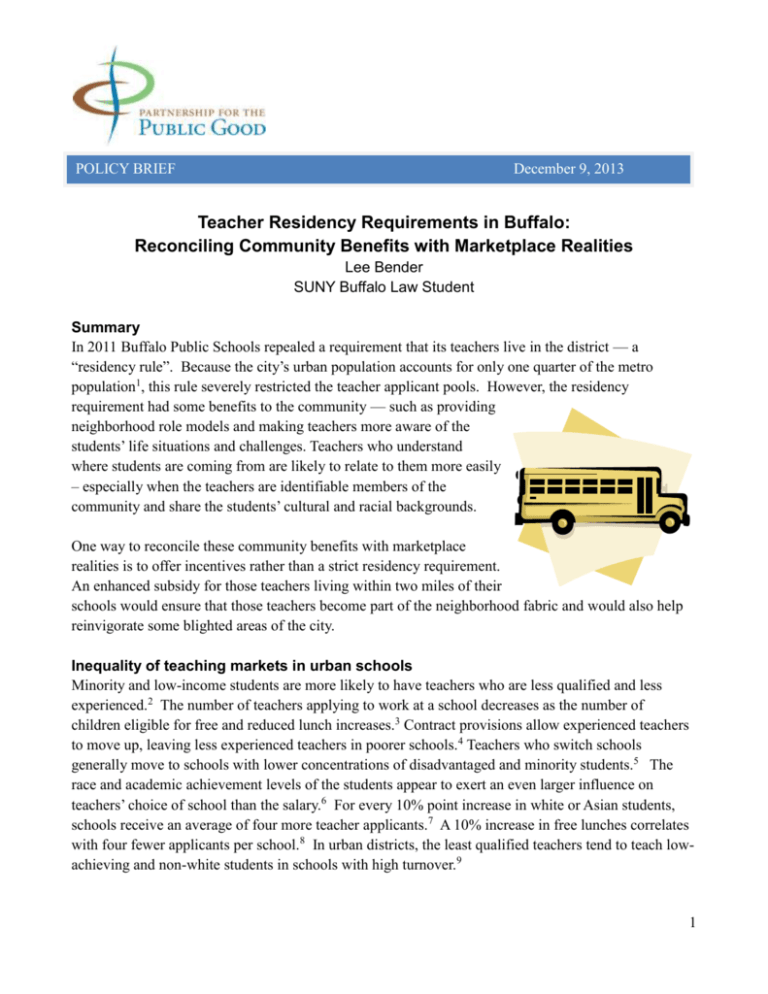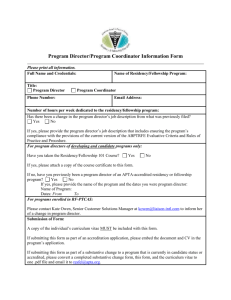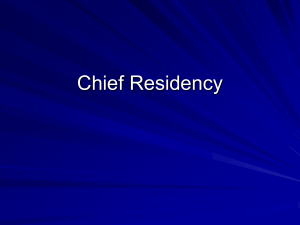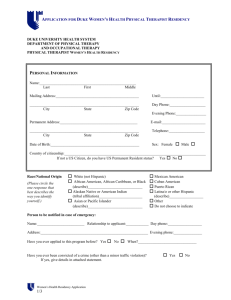Teacher Residency Requirements in Buffalo
advertisement

POLICY BRIEF December 9, 2013 Teacher Residency Requirements in Buffalo: Reconciling Community Benefits with Marketplace Realities Lee Bender SUNY Buffalo Law Student Summary In 2011 Buffalo Public Schools repealed a requirement that its teachers live in the district — a “residency rule”. Because the city’s urban population accounts for only one quarter of the metro population1, this rule severely restricted the teacher applicant pools. However, the residency requirement had some benefits to the community — such as providing neighborhood role models and making teachers more aware of the students’ life situations and challenges. Teachers who understand where students are coming from are likely to relate to them more easily – especially when the teachers are identifiable members of the community and share the students’ cultural and racial backgrounds. One way to reconcile these community benefits with marketplace realities is to offer incentives rather than a strict residency requirement. An enhanced subsidy for those teachers living within two miles of their schools would ensure that those teachers become part of the neighborhood fabric and would also help reinvigorate some blighted areas of the city. Inequality of teaching markets in urban schools Minority and low-income students are more likely to have teachers who are less qualified and less experienced.2 The number of teachers applying to work at a school decreases as the number of children eligible for free and reduced lunch increases.3 Contract provisions allow experienced teachers to move up, leaving less experienced teachers in poorer schools.4 Teachers who switch schools generally move to schools with lower concentrations of disadvantaged and minority students.5 The race and academic achievement levels of the students appear to exert an even larger influence on teachers’ choice of school than the salary.6 For every 10% point increase in white or Asian students, schools receive an average of four more teacher applicants.7 A 10% increase in free lunches correlates with four fewer applicants per school.8 In urban districts, the least qualified teachers tend to teach lowachieving and non-white students in schools with high turnover.9 1 Teachers also prefer to teach in schools in their home towns and near their homes; they are less likely to leave their place of origin than many other professionals.10 Because most teachers come from middle or upper class communities, this makes it less likely that those who obtain teaching degrees would choose to serve impoverished schools. Development of residency requirements Requiring municipal employees and officials, including teachers, to be residents of the areas they served became a widespread practice in the US during the 1800s.11 At the turn of the twentieth century, however, Progressives fought to ensure that the best candidates for office were given a chance at election,12 and most cities abolished or refused to enforce residency requirements by the 1920s.13 By the late 1960s Buffalo was one of a few large American cities that retained the requirement in some form.14 But in the late 1970s, the requirement made a comeback nationally, due in part to a Supreme Court decision upholding its constitutional validity.15 The desire to retain middle class residents (and their tax revenues) also fueled this revival.16 However, teacher residency requirements once again became less popular during teacher shortages in the late 1990s.17 Arguments in favor of residency requirements A residency requirement can benefit cities and students in many ways. Most importantly, teachers living in students’ neighborhoods gain a better understanding of the lives and cultures of students and parents and become more effective at relating to them.18 Further, resident teachers have a personal stake in the district due to tighter community connections and a desire for quality schools for their own children.19 Residency requirements can improve cities’ economic status by reducing unemployment and generating taxes from middle class salaries.20 They can help to curb middle-class flight, make it easier for teachers to meet with parents after school hours21, and foster a more cooperative approach in negotiations.22 Arguments against residency requirements Residency requirements may add another obstacle in a profession with numerous barriers to entry.23 Opponents argue that residency rules do not significantly increase sensitivity to students’ issues and have little impact on preventing flight from the city. 24 Instead, they claim, the practice has the potential to be discriminatory, violate a constitutional right, and limit the district’s potential talent pool.25 Buffalo’s approach to residency requirements In 1992, the Buffalo Board of Education re-enacted the requirement that teachers be residents of the city.26 New hires were required to become city residents within six months of hiring.27 A 2002 amendment removed the residency requirement for those filling a pressing need or when the supply of 2 certified city residents was exhausted.28 Members of Buffalo’s African American community fought for the residency requirement in order to address the school district’s failure to hire enough African American and Hispanic teachers.29 Advocates also argued that those living in the city, especially graduates of the Buffalo Public Schools, are the most effective teachers with the district’s students.30 According to the School Board member from the city’s Park District, resident teachers are particularly involved in their neighborhoods. 31 On March 23, 2011, the Board of Education abolished the city’s residency requirement in a five-to-four vote.32 The five-member majority believed the change would attract better teachers and expand the applicant pool.33 The board’s failure to obtain more public feedback before voting outraged community members, including some City Councilmembers.34 Those opposed to the change believed city population would begin to decrease more quickly and that it would weaken the sense of community within schools due to teacher relocation.35 Since the rule was repealed there has been an increase in teachers living outside of the city.36 Other cities’ experiences with residency requirements Buffalo is not the only district to reconsider residency requirements in recent years. Currently, most cities do not have teacher residency requirements. In 2001, Philadelphia, Providence, and Pittsburgh abolished their teacher residency requirements. By 2006, Chicago and Milwaukee were the only two of the nation’s 50 largest school districts with residency requirements,37 and Wisconsin’s governor is currently attempting to pass legislation denying cities the ability to impose residency requirements on municipal employees.38 Some Wisconsinites contend that repealing residency requirements for municipal employees has caused employees to leave cities, which then deteriorate due to lost population and tax base.39 But others question how well municipal employees are integrated in districts with residency requirements. They argue that in Milwaukee, teachers have not been incorporated into the neighborhoods they serve, but have instead developed pockets away from the neighborhoods in areas bordering the suburbs.40 Furthermore, more than 82% of education students polled in Milwaukee would prefer to teach in a district without residency requirements, and 62% indicated they were less likely to seek a position there due to the requirement.41 When Philadelphia removed its residency requirement, the number of certified teachers increased and vacancies dropped.42 3 Is a residency requirement a good idea for the Buffalo Public Schools? Residency requirements in Buffalo Public Schools may limit candidate pools. A survey of more than 350 Buffalo State College education students revealed that 71% of the students would not work in Buffalo Public Schools due to the residency requirement.43 However, resident teachers clearly bring some benefits to the schools and the community.44 There is a divide between community benefits and current marketplace realities that must be reconciled. In order to obtain the benefits of residency requirements without losing quality candidates, the city and school district must think creatively about how to make teaching jobs attractive to quality applicants who already are or are willing to become integral parts of the community. Alternative measures Given the current difficulties urban schools face in attracting and retaining quality teachers, residency requirements as they have traditionally been used may be more detrimental to schools than helpful. Furthermore, some teachers who have not grown up in cities or attended urban public schools may still face a cultural disconnect even if forced to live in the city, and they may choose to live in neighborhoods that have little in common with the schools where they teach. Thus, school districts such as Buffalo may wish to develop programs both to entice quality teachers to the city and to grow them from within the community. First, the district could capitalize on teachers’ strong preference to remain in their neighborhoods. The district could develop a partnership with local universities to provide incentives for City of Buffalo students who become teachers for the district for a term of ten years. This would effectively encourage students to achieve while providing neighborhoods with role models that the community helped raise and grow. These teachers would be intimately connected with and invested in their neighborhoods and understand the students’ struggles and lives. Second, the city or district could offer teachers subsidies to buy homes in the city. Although this has been attempted in other cities, it has not always dealt with the problem of teachers selecting only prosperous neighborhoods within the city. A two-tiered system may be more effective at keeping teachers in the neighborhoods they serve. The city or district could offer a subsidy for teachers buying homes in the city, but offer a bonus incentive to those who buy a home within two miles of their school. Subsidy approaches and scholarships have been offered by the district in the past.45 However, 4 the city has few resources, making it difficult to offer any financial incentives.46 Private partners must be identified for these programs to be viable. Finally, the district could allow teachers to live outside of the city, but award positions at top performing schools to city residents only. This would likely attract higher-quality teachers to the city due to the desire to teach in a higher achieving environment. Creative problem solving can help Buffalo Public Schools attract quality, invested teachers who connect with neighborhoods they serve. 1 Ramon Garcia, Population Trends in Buffalo-Niagara, Partnership for the Public Good, Aug. 8, 2012, p. 1, http://www.ppgbuffalo.org/wp-content/uploads/2012/08/population-2012-garcia.pdf 2 Mimi Engel & Brian A. Jacob, New Evidence on Teacher Labor Supply, NBER Working Paper 16802, p. 1, http://www.nber.org/papers/w16802 (“Teacher Labor Supply”) 3 Id. at 3 4 Eric A. Hanushek & Steven G. Rivkin, Constrained Job Matching: Does Teacher Job Search Harm Disadvantaged Urban Schools?, NBER Working Paper 15816, p. 4 http://www.nber.org/papers/w15816 5 Id. 6 Id. at 5 7 Id. at 14 8 Id. at 15 9 Id. at 4, 24 (However, the teachers switching out are on average less effective, indicating that the turnover does not deplete poorer schools of effective teachers, but turnover may influence the school environment. p. 25) 10 Id. at 6 11 Id. 12 Id. 13 Id. 14 Id. 15 Id. at 6 16 Id. 17 Id. at 7-8 18 Id. at 1 19 Id. 20 Id. 21 Anecdotally, Buffalo residents have noted the difference between teachers who live in the suburbs and flock from schools at dismissal time and those who reside in the community. Buffalo Public School board member,Louis Petrucci, Personal Communication Feb. 28, 2013 (“Petrucci”) 22 Id. at 6-7 23 Id. at 1 24 Id. at 7 25 Id. 26 Enough Votes to Overturn Residency Rule for Buffalo Teachers?, The Buffalo News, Dec. 8, 2010, http://blogs.buffalonews.com/school_zone/2010/12/enough-support-to-overturn-residency-rule-for-buffalo-teachers.html 27 Residency Policy for Probationary Teachers and Administrators of the Buffalo Board of Education, p. 1, http://www.btfny.org/news_alerts/board_residency_policy.pdf 28 Id. at 2 29 Teacher Residency Law Abolished!, The Challenger Community News, March 31, 2011, http://challengercn.com/?p=2264 (“Challenger”) 30 Petrucci 31 Id. 5 32 Challenger Jaclyn Asztalos, Reconsidering Residency Requirement for Buffalo Teachers, WKBW Eyewitness News, April 13, 2011, http://www.wkbw.com/news/local/Reconsidering-Residency-Requirement-for-Buffalo-Teachers-119759924.html (“Reconsidering Residency”) 34 Challenger 35 Reconsidering Residency 36 However, some of those leaving the city may have been residents in address only, while truly residing outside of the city already. Petrucci 37 Milwaukee at 8 38 Budget is the Wrong Place to Change Residency Rules (Opinion), Wisconsin Journal Sentinel, Feb. 23, 2013 39 Don Walker, More From Chiefs Flynn and Rohlfing on Residency, Milwaukee, Wisconsin Journal Sentinel, Feb. 15, 2013 40 Milwaukee at 2 41 Id. at 13 42 Id. at 2 43 Id. at 13 44 Petrucci 45 Id. 46 Id. 33 ________________________________________________________________________ Partnership for the Public Good www.ppgbuffalo.org 237 Main St., Suite 1200, Buffalo NY 14203 6


